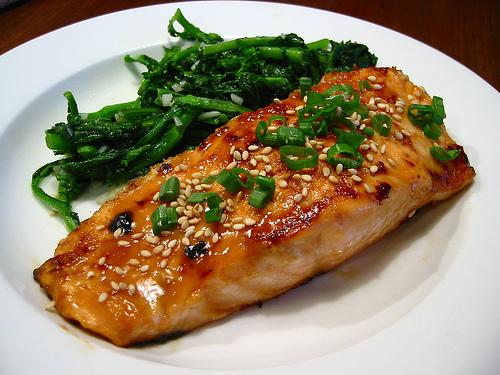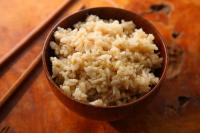
Health Benefits
Although fish is lean, it does contain some healthy oil. Known as omega-3 fatty acids, these fish oils are thought to offer some amazing health benefits, such as helping to prevent heart disease and cancer, treating psoriasis and arthritis, and relieving the agony of migraine headaches and helping with weight control. Fatty fish tend to have more omega-3s than leaner fish, but even "fatty" fish contain less fat than lean beef or chicken. Even canned fish like tuna, sardines, and salmon, when eaten bones and all, pack your meal with plenty of good-for-your-bones calcium, too.
Selection and Storage
When buying fresh fish, always smell it. If you detect a "fishy" odor, don't buy it. Whether you buy whole fish, fish fillets, or steaks, the fish should be firm to the touch. The scales should be shiny and clean, not slimy. Check the eyes: They should be clear, not cloudy and bulging, and not sunken. Fish fillets and steaks should be moist. If they look dried or curled around the edges, they probably aren't fresh.
It's best to cook fresh fish the same day you buy it. (Fish generally spoil faster than beef or chicken, and whole fish generally keeps better than steaks or fillets.) But fish will keep in the refrigerator overnight if you store it in an airtight container over a bowl of ice.
If you need to keep it longer than a day, freeze it. The quality of thawed, frozen fish is better when it freezes quickly, so freeze whole fish only if it weighs two pounds or less. Larger fish should be cut into pieces, steaks, or fillets to ensure a quick freeze. Lean fish will keep in the freezer up to six months -- three months for fatty fish.
When buying most shellfish -- clams, oysters, lobsters, crabs, and crayfish -- it's imperative they still be alive. Live lobsters and crabs are easy to spot. Clams and oysters are trickier, though; you must be sure the shell is closed tightly or closes when you tap the shell.
Fish and shellfish have been dogged by safety questions, including those arising from man-made contaminants. Oysters and clams, if eaten raw, carry a particular risk of passing on diseases such as hepatitis or Norwalk-like viruses. Cook
 Order Logbook
Order Logbookthem thoroughly to avoid food-borne illness. Partially cooked shellfish can still harbor harmful bacteria.
Pesticides, mercury, and chemicals like PCB sometimes find their way into fish. Though fatty fish is richer in omega-3s, they're also more likely to harbor environmental contaminants.
Here are some precautions you can take to reduce the odds of eating contaminated fish:
Eat fish from a variety of sources.
Choose open-ocean fish and farmed fish over freshwater; they are less likely to harbor toxins.
Eat smaller, young fish. Older fish are more likely to have accumulated chemicals in their fatty tissues.
Before you fish, check with your own state's advisories about which waters are unsafe for fishing. Try the Department of Public Health or the Department of Environmental Conservation.
Don't make a habit of eating the fish you catch for sport if you fish in the same place over and over again.
Avoid swordfish and albacore. They may be contaminated with mercury.
Preparation and Serving Tips
For the uninitiated, fish is most perplexing to prepare. But the number one rule is: Preserve moistness. That means avoiding direct heat, especially when preparing low-fat varieties of fish; you'll get the best results if you use moist-heat methods such as poaching, steaming, or baking with vegetables or in a sauce. Dry-heat methods such as baking, broiling, and grilling work well for fattier fish.
Fish cooks fast, so it's easy to overcook it. You can tell fish is done when it looks opaque and the flesh just begins to flake with the touch of a fork. If it falls apart when you touch it, it's too late; the fish is overdone. The rule of thumb for baking fish is to cook 8 to 10 minutes per inch of thickness, measured at the fish's thickest point. For grilling and pan-frying or broiling, cook 4 to 5 minutes per inch of thickness.
For fish soups, stews, and chowders, use lean fish. An oily fish will overpower the flavor of the broth. Citrus juices enhance the natural flavor of fish. Some favorite fish seasonings are dill, tarragon, basil, paprika, parsley, and thyme.
To succeed at long-term weight loss, it's important to learn new ways of eating that you enjoy. You can lose weight easily when you enjoy healthy foods, like fish, and prepare delicious, yet low-fat, fish recipes.
Watch Video



